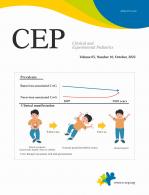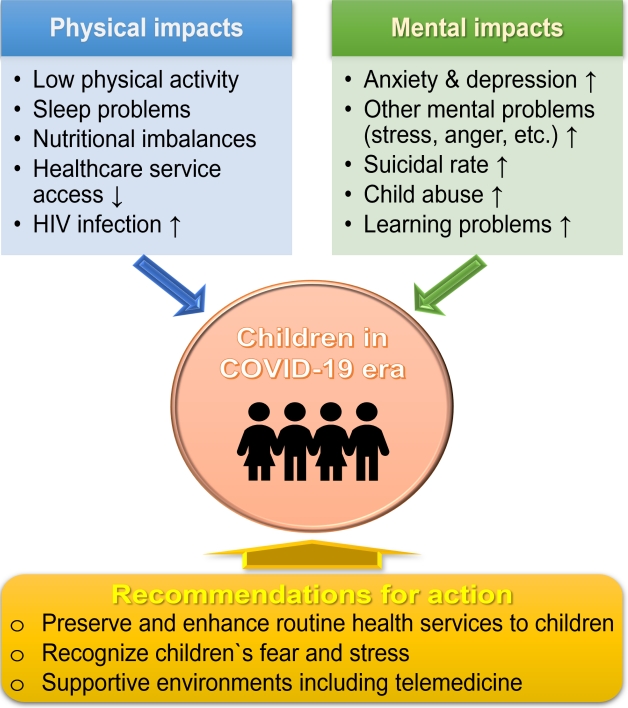The coronavirus disease 2019 (COVID-19) pandemic has continued for more than 2 years. Since the advent of COVID-19 vaccinations, routine life has partially recovered. However, many cities and countries are still fighting the COVID-19 pandemic. COVID-19 has a very high rate of infectivity [1], and many governments have implemented social distancing or lockdown measures. Many schools also closed, and students stayed at home. Those situations caused many problems for children and adolescents [2-4]. The Centers for Disease Control and Prevention has described the difficulties in the lives of children and adolescents after COVID-19 included changes in routine, breaks in the continuity of learning, breaks in the continuity of health care, missing of significant life events, and loss of security and safety [5].
The impact of COVID-19 on children can be broadly divided into physical and mental problems (Fig. 1). There are several physical obstacles to children’s health. COVID-19 negatively influenced children’s physical activity, particularly those of lower socioeconomic background [6]. While physical activity time decreased, screen time and social media use doubled. This led to an increased risk of trouble sleeping or sleep loss. Researchers found that the prevalence of overweight increased, consumption of unhealthy foods increased, and consumption of fruits and vegetables decreased [3,4]. On the other hand, as of March 2021, an estimated 204 million children missed school meals [7]. Healthcare services access/use declined, and diabetes is not well controlled in some younger and lower socioeconomic groups [3,4]. An additional 124,000 children could be infected with human immunodeficiency virus (HIV) if prevention services were disrupted for 6 months. And finally, 66% of countries reported disrupted child-related services due to COVID-19 [8].
Recent studies suggested that COVID-19 can significantly impact the mental health of children and adolescents [2]. Anxiety and depression are the most common increases. In addition, loneliness, psychological distress, anger, irritability, boredom, fear, posttraumatic stress, and stress have been linked. These mental disorders may be new or preexisting. Risk factors for anxiety include lack of routine, female sex, adolescent age, excessive exposure to COVID information and media, previous mental health problems, community case frequency, and having a relative doing first-line work related to COVID-19. Some studies have reported the impact of COVID-19 on the health of children and adolescents. Suicide rates have increased, as have those of anxiety, depression, hyperactivity/inattention, behavioral difficulties, and stress. The number of child abuse cases also reportedly increased, while the number of child abuse reports has decreased [3,4]. Learning problems in children are also crucial. Children born during the pandemic have significantly reduced verbal, motor, and overall cognitive performance versus prepandemic children [9]. The United Nations International Children’s Emergency Fund announced that at least 463 million children worldwide could not access remote learning during the COVID-19 school closures in 2020 [8]. A cohort study of 350,000 children aged 8–11 years in the Netherlands reported little or no progress during virtual schooling. This was especially noticeable in less educated homes [10].
Although children and adolescents are less directly vulnerable to COVID-19 infection, the burden imposed on the health system from this pandemic poses significant threats to their health and well-being of children and adolescents. As the pandemic continues, countries have shifted significant financial, commodity, and human resources to respond to it. This disruption could significantly increase preventable child mortality cases worldwide. COVID-19 and pandemic response efforts have resulted in school closures, a lack of social gatherings, and increased social isolation. Children and adolescents must manage severe anxiety, stress, and confusion. These stressors have a severe impact on the mental health of children and adolescents and their well-being in the short term and the months or years to come. Children and adolescents may be at an increased risk of exposure to violence during lockdown, and adolescents may be at an increased risk of HIV infection and unplanned pregnancy. All of these factors have immediate and long-term negative impacts on the health of children and adolescents. Recommended actions can improve the health care of children in the COVID-19 era [5,11]. Caregivers and health care providers should help children and adolescents recognize and address their fear and stress and teach and reinforce everyday preventive actions to help keep them healthy and socially connected. They should also preserve and enhance routine health services for children, advocate access to a supportive environment, enhance accessible mental health services, and develop telemedicine offerings [5,12]. Parents, guardians, academic societies, and the government should cooperate to support the mental health of children and adolescents.






 PDF Links
PDF Links PubReader
PubReader ePub Link
ePub Link PubMed
PubMed Download Citation
Download Citation


